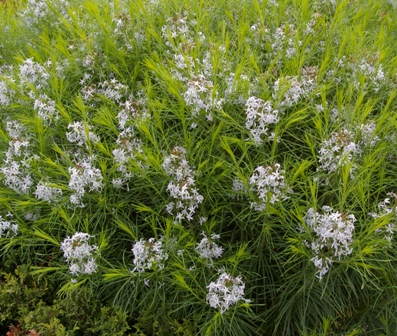This is the time of year when all my work to entice birds into the garden begins to payoff. The rudbeckia that I allowed to go to seed are being feasted upon. You haven’t seen cute until you’ve seen a black capped chick-a-dee dangling on a slender stem grabbing the seeds. The debris I allow to stay on the beds below my shade trees has become home to all kinds of critters that the juncos, crested sparrows, varied thrush and towhees love to scratch for. Mr. & Mrs. Robin like it too.
The suet feeder (that we keep full year-round) is now attracting a pair each of ruby crowned kinglet, townsend’s warbler and downy woodpeckers. If there are pairs, there will be babies! This feeder is hanging from a branch of our Hinoki Cypress and is visible from our living room window.
The berries on the Cotoneaster franchetii are nice and mushy now, just right for the robins and flickers. This is true for the Viburnum sargentii, Aronia and Sarcococca ruscifolia as well.
The “chipper pile” as we call it (pruning debris from last year and this spring) is alive with the ground-nesters; mostly sparrows and wrens. We discovered by accident that leaving this pile from fall through to the next summer brought as least a half dozen new species of birds into the garden. If you don’t want to do a debris pile, you can create a “thicket” with various ornamental plants. Climbing or rambling roses left without support work very well. A dense planting of Berberis or Pyracantha works too. Allowing vigorous vines like Clematis Montana or ternaflora to grow on a low support will also provide a predator-proof place to nest. My Hinoki cypress (Chamaecyparis obtusa nana) and Cryptomeria japonica ‘Black Dragon’ and ‘Elegans’ along with the neighbors’ 50ft. Doug Firs and Port Orford Cedars supply the birds with good shelter from spring storms and good nesting places. I leave dead wood around in several spots to encourage the critters that feed on that wood. They provide good food especially for the wood-peckers and flickers.
A dense planting of Berberis or Pyracantha works too. Allowing vigorous vines like Clematis Montana or ternaflora to grow on a low support will also provide a predator-proof place to nest. My Hinoki cypress (Chamaecyparis obtusa nana) and Cryptomeria japonica ‘Black Dragon’ and ‘Elegans’ along with the neighbors’ 50ft. Doug Firs and Port Orford Cedars supply the birds with good shelter from spring storms and good nesting places. I leave dead wood around in several spots to encourage the critters that feed on that wood. They provide good food especially for the wood-peckers and flickers.
My husband has to work a little harder to keep the sunflower, thistle and millet seed available for those birds who are expending a lot of energy courting and mating. We often mix egg shells in with the seed to provide some extra calcium. Be sure to sterilize them in the microwave and pulverize to a fine powder.
The humming birds are kept happy with the blooms of Viburnum bodnantese ‘Pink Dawn’. This tall shrub blooms from November through March. The hummers will then move on to the scarlet Flowering Current that is about to burst. Pulmonarias are a perennial that are a special favorite of the little birds too. These are low growers so be sure there is open space around them so that cats can’t sneak up on the birds. Andy and I happened to see a Humming bird gathering dryer lint from a shelf in my breezeway. What a gift!
I’ll be getting my main water fountain up and running soon. My decorative bird bath will replace the winter substitute and a little fountain on the front porch completes the group. Moving water is known to attract migrating birds in if even for a brief visit.
As you may have concluded, the more variety of plants and micro-environments you can create in your garden, the more variety of bird you can attract. Have fun trying to entice the lovely and unusual into your garden.
Nadine












